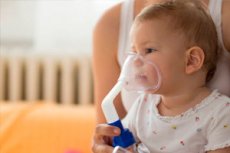New publications
Early Childhood Ozone and Asthma Risk: Even 'Low' Levels Linked to Symptoms by Ages 4-6
Last reviewed: 18.08.2025

All iLive content is medically reviewed or fact checked to ensure as much factual accuracy as possible.
We have strict sourcing guidelines and only link to reputable media sites, academic research institutions and, whenever possible, medically peer reviewed studies. Note that the numbers in parentheses ([1], [2], etc.) are clickable links to these studies.
If you feel that any of our content is inaccurate, out-of-date, or otherwise questionable, please select it and press Ctrl + Enter.

Children who lived in areas with slightly higher ozone levels during their first two years of life (an average difference of only +2 ppb) were more likely to have current asthma (OR≈1.31) and wheezing (OR≈1.30) by age 4–6. This association was no longer observed by age 8–9. The effect was also seen with pollutant mixtures (PM2.5 and NO₂). The study was published in JAMA Network Open.
What was studied
The researchers pooled data from three prospective ECHO-PATHWAYS cohorts from six US cities (Memphis, Seattle, Yakima, Minneapolis, Rochester, San Francisco). The analysis included 1,188 full-term infants with complete address histories from birth to age 2 years and respiratory symptom questionnaires at ages 4–6 and 8–9 years.
- Exposure: Average ozone (O₃) levels at home for children aged 0–2 years. Estimated using a high-fidelity spatiotemporal model (validated forecasts updated every two weeks). For multi-component models, NO₂ and PM2.5 were added.
- Outcomes: according to validated ISAAC questionnaires - “current asthma” and “current wheeze” at 4–6 years (primary), as well as “strict asthma” and wheezing trajectories (early/late/persistent) at 8–9 years (secondary).
- Control factors: gender, age, year of birth, centre, mother's education, mother's asthma, passive smoking after birth, area deprivation index, family income/size, breastfeeding, pets, smoking during pregnancy, etc.
The environment in the study was not at all "dirty": the average O₃ in early life was 26.1 ppb (low-moderate for the US).
Key Results
- At 4–6 years of age, every +2 ppb O₃ in the first two years of life is associated with:
- current asthma: OR 1.31 (95% CI 1.02–1.68);
- current wheezing: OR 1.30 (95% CI 1.05–1.64).
- At 8–9 years of age, no associations with “strict” asthma and wheezing trajectories were found—perhaps more recent exposures are more important, or children “outgrow” early phenotypes.
- Pollutant mixtures: In the Bayesian model (BKMR), higher O₃ in the background of average NO₂ and PM2.5 levels was also associated with a higher odds of asthma/wheezing at 4–6 years.
- Nonlinearity: for asthma, a plateau effect is observed around 27 ppb O₃ (further increases result in less increase in risk).
- The results remained generally robust across different sets of adjustments, but became less precise (wider confidence intervals) in sensitive analyses—an important reminder that this is an observational study.
Why is this plausible?
Toxicology has long shown that early life is a “critical window” for the lungs: ozone initiates oxidative stress, inflammation, affects airway remodeling and alveologenesis. This may lay the foundation for asthmatic phenotypes that manifest as early as preschool age.
What this means for parents and doctors
- Even at low annual average ozone levels, small differences in early childhood exposure are associated with measurable risk of symptoms by 4–6 years of age.
- In the clinic: it is worth clarifying the environmental background in the anamnesis (episodes of smog/heat, proximity to highways) and more actively recommending prevention to families of children from risk groups (asthma in the mother, passive smoking, etc.).
- In everyday life: on days with high O₃ (usually warm sunny afternoons), move active walks to the morning/evening, look for green routes away from traffic, ventilate when the level is lower, use indoor air filtration if necessary.
- At the policy level: measures to reduce ozone precursors (NOₓ, VOCs) – transport, industry, solvent evaporation – have the potential to reduce childhood asthma. Ozone is not an “exhaust”, it is formed in the atmosphere by the sun, so the fight against its “parents” is critical.
Important Disclaimers
- Associations ≠ causality: despite careful corrections, residual confounding is possible (e.g., features of the microclimate of the home, time spent outdoors).
- Outcomes are based on caregiver reports, not spirometry/biomarkers.
- The effects at 8–9 years of age were not confirmed; it is likely that closer-to-the-outcome effects or a change in whistle phenotypes with age play a role.
Why is this research important?
Childhood asthma rates in the U.S. remain high, and ozone is the most frequently exceeded air quality standard. The work shows that the 0–2-year window can be critical even in places where annual average O₃ is low. This strengthens the case for early prevention and a multipollutant approach to environmental policy.
